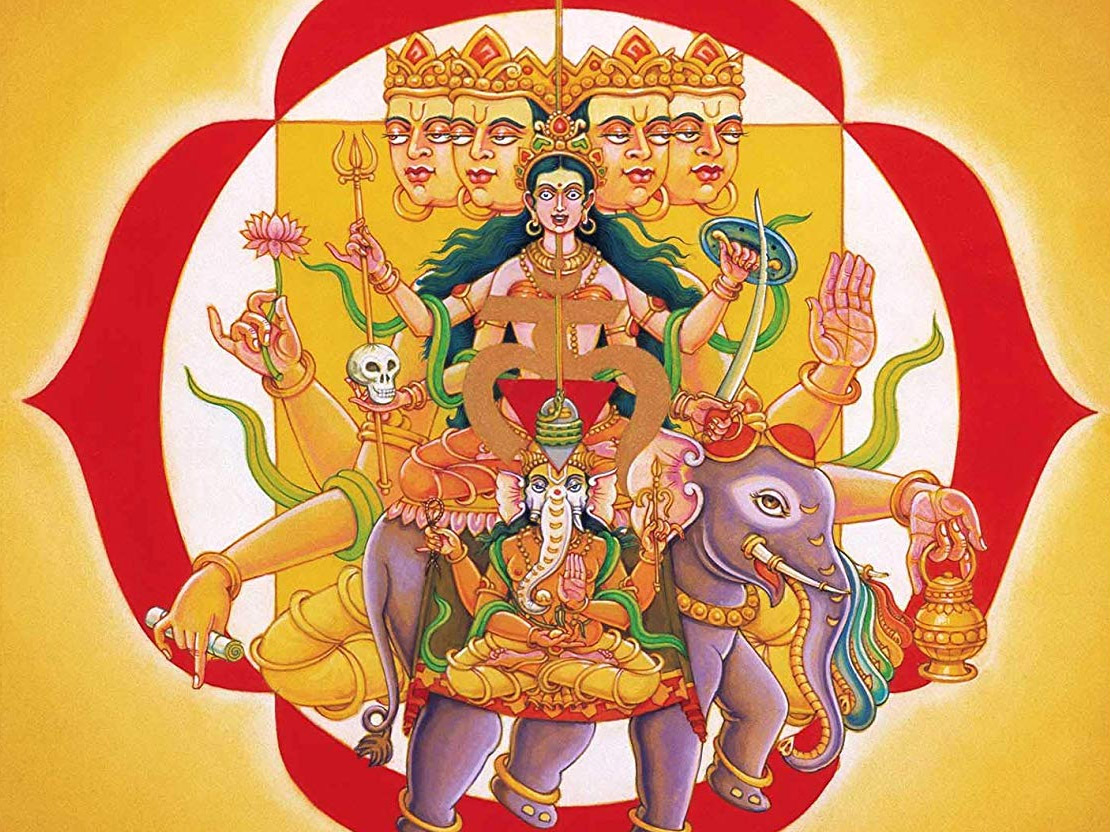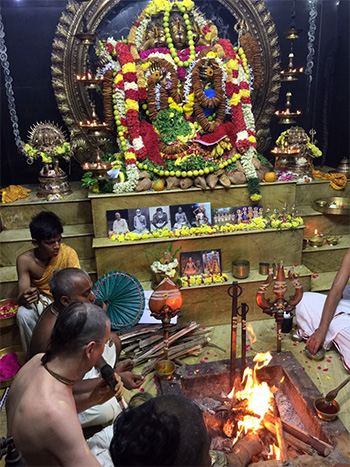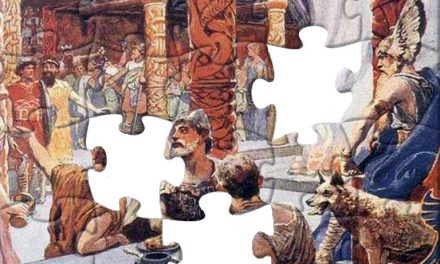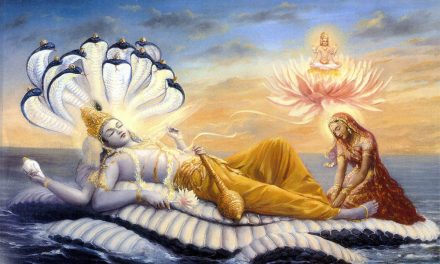(This was originally written in 2001 for our email newsletter, Tattva Prakasha.)
Welcome to the seventh issue of Tattva Prakasha. This week our main topic of discussion will be the Vedantic conception of sound. If you are a new subscriber to Tattva Prakasha, I would like to mention that though most of our articles deal with general philosophy, this issue will be a little more technical due to the importance of the subject. Since the topic is technical, we have included a small glossary of Sanskrit words at the end of this issue. If you get confused while reading, you can refer to the glossary to put everything in proper context.
In the Vedantic traditions sound is considered one of the most important principles of existence, as it is both the source of matter and the key to become free from it. One who can thoroughly understand the four stages of sound as explained in the Vedic texts can utilize this science to become free from the bondage of matter.
When trying to understand the four levels of sound, we must first understand what is “sound” as defined in the scriptures. In the Srimad Bhagavatam (3.26.33) we find an interesting definition for sound (shabda) as follows:
arthashrayatvam shabdasya
drashtur lingatvam eva ca
tan-matratvam ca nabhaso
lakshanam kavayo viduh
“Persons who are learned and who have true knowledge define sound as that which conveys the idea of an object, indicates the presence of a speaker and constitutes the subtle form of ether.”
This may not be an absolute definition of sound, as there are various levels of sound to define, but it provides us with a solid foundation to begin our study of this topic. This definition, as given in Srimad Bhagavatam, is very interesting in that it differs completely from western and modern views of defining sound.
First, those who are learned and who have true knowledge define sound as that which conveys the idea of an object. Sound is not just the vibration created by the meeting of two objects. Sound is that which conveys the idea of an object. The exact word used in this connection is “artha-ashraya” or “the shelter of the meaning”. In the Vedic conception the aksharas (letters) are bijas, or seeds of existence. The audible sound is categorized into 50 alphabets of Sanskrit starting from “a” and ending with “ksha”. Hence the alphabet is called “akshara”, which literally means “infallible” or “supreme”. Akshara is also a synomyn for pranava (Om), the sum of all syllables and source of all vedic hymns. The Bhagavad Gita confirms this as follows:
karma brahmodbhavam viddhi
brahmakshara-samudbhavam
tasmat sarva-gatam brahma
nityam yajne pratisthitam
“Regulated activities are prescribed in the Vedas, and the Vedas are directly manifested from akshara, the sacred syllable Om. Consequently the all-pervading Transcendence (pranava or the syllable ‘Om’) is eternally situated in acts of sacrifice.”
Karma, or duty, is manifested from the Vedas. This manifestation is not exactly direct, for one is spiritual and the other is material. This is indicated by the word udbhavam. On the other hand, the manifestation of the vedas from the pranava (Om) is direct, and thus the word used to describe it is sam-udbhavam, and not just udbhavam.
In the tantras the aksharas are traced back to their material source level which is a particular deity of Shakti. Each of her stages of manifestation are phases in the evolution of the universe. Thus the aksharas are potent sound, constitutionally connected to objects as sound (shabda) and its meaning (artha).
This is interesting in that it draws a distinction between sound and noise. Noise, as distinct from sound, is not the artha-ashraya, or the shelter of meaning.
Sri Baladeva Vidyabhushana in his commentary to Vedanta Sutra 1.3.28 says that the creation of all living entities proceeds from the remembrance of their form and characteristics by Lord Brahma reciting the corresponding words. From this we can begin to understand to potency of sound and its meaning.
The second aspect of Srimad Bhagavatam’s definition of sound that is unique from modern thought is that sound is defined as “that which indicates the presence of a speaker”. Thus sound must be a product of consciousness. In this senses, sound is sometimes referred to as vak, or speech, throughout the Vedic texts.
In the tantra system the purva mimamsaka’s theory of the eternality of shabda (sound) and artha (meaning) is accepted. They go a little further to assert that shabda and artha are the embodiment of Shiva and Shakti as the universe itself. They name their original source as shabdartha-brahman instead of a mere shabda-brahman. For, that is the source of both the objects and their descriptions. Words and their meanings – what they denote in the objective world – are the variety of manifestations of shakti.
As sound is of the nature of the varnas (syllables) composing it, the tantra affirmes that the creative force of the universe resides in all the letters of the alphabet. The different letters symbolize the different functions of that creative force, and their totality is designated as matrika or the “mother in essence”.
Thus Tantra sees the mantras as not just a mere combination of whimsical sounds but as the subtle form of the presiding deity; and the real purpose of one’s meditation through the mantra is to communicate with the deity of that particular mantra.
Just as a sankalpa – a pure thought – has to pass through several stages before it actually manifests as concrete creative force, the sound of a particular mantra also has to pass through several stages before it is fully experienced by the listener in perfection. These stages are termed as para, pashyanti, madhyama and vaikhari.
Each level of sound corresponds to a level of existence, and one’s experience of sound depends upon the refinement of one’s consciousness.
It takes a realized consciousness to experience the full range of sound, the full range of existence. The seers who can comprehend the four stages of sound are known as Manishis.
The higher three forms of shabda are described in the Rig Veda as hidden in “guha”, or within the self, whereas the forth is the external manifested speech, known as laukika bhasha.
These four levels of sound correspond to four states of consciousness. Para represents the transcendental consciousness. Pashyanti represents the intellectual consciousness. Madhyama represents the mental consciousness. And Vaikhari represents the physical consciousness. These states of consciousness correspond with the four states known technically as jagrat, svapna, sushupti, and turiya – or the wakeful state, the dreaming state, the dreamless state, and the transcendental state.
Shabda-brahman in its absolute nature is called para. In manifestation the subtle is always the source of the gross, and thus from para-vak manifests the other three forms of sound.
Though the manifestation of sound takes place from para-vak down to vaikhari-vak (or fine to gross), in explaining these stages we will begin from the external vaikhari-vak, as that is the sound we all have most experience of.
Vaikhari-vak is the grossest level of speech, and it is heard through the external senses. When sound comes out through the mouth as spoken syllables it is called as vaikhari.
Madhyama-vak is the intermediate unexpressed state of sound, whose seat is in the heart. The word Madhyama means “in between” or “the middle”. The middle sound is that sound which exists between the states of sushupti and jagrat. Madhyama-vak refers to mental speech, as opposed to external audible speech. It is on this level that we normally experience thought. Some hold that wakeful thought is still on the level of vaikhari.
In the manifestation process, after sound has attained the form of pashyanti-vak, it goes further up to the heart and becomes coupled with the assertive intelligence, being charged with the syllables a, ka, cha, tha, ta, etc. At this point it manifests itself in the form of vibratory nada rupa madhyama-vak. Only those who are endowed with discriminative intelligence can feel this.
On the levels of madhyama and vaikhari, there is a distinction between the sound and the object. The object is perceived as something different from the sound, and sound is connected to an object mostly by convention.
Pashyanti-vak is the second level of sound, and is less subtle than para-vak. Pashyanti in Sanskrit means “that which can be seen or visualised”.
In the pashyanti stage sound possesses qualities such as color and form. Yogis who have inner vision can perceive these qualities in sound. On this stage the differences between language do not exist, as this sound is intuitive and situated beyond rigidly defined concepts. On the stage of pashyanti-vak, speech is intuitively connected to the object. There is near oneness between the word and the experience described.
Pashyanti-vak is the finest impulse of speech. The seat of pashyanti is in the navel or the Manipura Chakra. When sound goes up to the naval with the bodily air in vibratory form without any particular syllable (varna), yet connected with the mind, it is known as pashyanti-vak.
Para-vak is the transcendent sound. Para means highest or farthest, and in this connection it indicates that sound which is beyond the perception of the senses.
Para-vak is also known as “rava-shabda” – an unvibratory condition of sound beyond the reach of mind and intelligence (avyakta), only to be realized by great souls, parama-jnanis.
On the stage of para-vak there is no distinction between the object and the sound. The sound contains within it all the qualities of the object.
In terms of the universal cosmology, vaikhari, madhyama and pashyanti correspond respectively to bhuh, bhuvah, and svah. The para-shabda ultimately corresponds to the Lord’s tri-pada-vibhuti.
Within the pashyanti-vak exists the nature’s iccha-shakti, or the power of will. Within the madhyama-vak exists the nature’s jnana-shakti, or the power of knowledge. And within the vaikhari-vak exists the nature’s kriya-shakti, or power of action.
The pranava, or the syllable “om”, is the complete representation of the four stages of sound and their existential counterparts. The existential realities are the physical (sthula) which is connected to the vaikhari-shabda, the subtle (sukshma) which is connected to the madhyama-shabda, the causal (karana) which is connected with the pashyanti-shabda, and the transcendental (para) which is related to the para-shabda. These four existential realities further correspond to the four states of consciousness.
The sthula sarira, or physical body, operates in the state of jagrat (wakeful state). It is in this realm of consciousness, and through this body, that the vaikhari-vak is manifested.
The sukshma-sarira, subtle or psychic body, operates in the state of svapna. It is in this realm of consciousness, and through this body, that the madhyama-vak is manifested.
The karana-sarira, or causal body, operates in the state of sushupti, or deep sleep. It is in this realm of consciousness, and through this body, that the pashyanti-vak is manifested.
The para-vak is manifested through the fourth state of consciousness, known as turiya.
The sacred syllable “om” is composed of three matras, namely “a”, “u”, and “m”. These three matras correspond respectively to bhuh, bhuvah and svah; jagrat, svapna and sushupti; sukshma, sthula and karana; and vaikhari, madhyama and pashyanti. Besides these three matras, the pranava (“a-u-m”) is also composed of a forth constituent, namely the a-matra or anahata-dhvani – the non-syllable or unstruck sound. For our practical understanding, this a-matra corresponds to the humming sound after one recites the “om” syllable. The a-matra represents the transendence, the turiya, the para-vak.
Thus the syllable om contains all elements of existence. It is the reservoir of all energies of the Supreme Lord, and for this reason Lord Krishna states in the Gita:
om ity ekaksharam brahma
“The single syllable Om is the supreme combination of letters.”
Elsewhere the Lord states:
yad aksharam veda-vido vadanti
“Those knowers of the Vedas recite Om (akshara).”
Why do they do this? Because the syllable om is the Supreme Lord and the potency of all Vedic mantras:
pranava sarva vedeshu
“Within all the Vedas, I am the symbol Om.”
Sri Chaitanya Mahaprabhu established the pranava as the maha-vakya (the greatest statement) of the vedas, for within it exist all Vedic hymns (and shabda). The world itself is a manifestation of this syllable. It is the sound representation of the Abslute Truth.
The vak is not a manifestation of the material nature, for the Vedanta sutra 2.4.4 states as follows:
tat-purvakatvad vacah
This indicates that the vak existed before the pradhana. Pradhana is the root of the material manifestation – the three qualities non-differentiated in absolute equilibrium. Yet prior to this is the vak. Thus the vak is non-material.
For this reason we find in the Vedanta Sutras the following statement:
anavriti shabdat
“Liberation by sound.”
Since sound is the non-material source of the material manifestation, it is the key by which we can become free from bondage. It is the thread-like link between the material and spiritual realms.
In describing the four phases of sound, sometimes the descriptions of one will overlap another, or sometimes an aspect of one will seem to be attributed to another. For example sometimes pashyanti is described as “mental sound”, whereas madhyama will be described as “intellectual sound”. This will require a deeper explanation of the intricacies of these stages of sound and their relationships. Such an explanation is not possible here at this time.
To study these concepts in greater depth one may refer to the Nada-bindu Upanishad, Bhartrihari’s Vakyapadadiya, Prashna Upanishad, Mundaka Upanishad, Mandukya Upanishad, Maitri Upanishad and Katha Upanishad, as well as the concepts of shabda, vak, matrikas, hiranyagarbha, four states of consciousness, etc., as found in the tantras and throughout the upanishads. One should remember that in Vedic study one will not generally find a book on a particular topic (such as “vaikhari”, etc.) One must study from numerous sources and assimilate a number of apparently diverse concepts. These concepts must then be harmonized internally. This constitutes the meditation and sacrifice of svadhyaya yajna.
For those who have assimilated these topics, they will find all this information contained in detail within nine technical verses of Srimad Bhagavatam beginning from 11.2.35 and ending at 11.2.43. For example, if one sees verses 38 through 40 one will find a complete explanation of sound in four levels and the process of manifestation. One must be trained to see the inner meaning of words, for these topics are discussed in esoteric and confidential manners:
paroksha-vada rishayah
paroksham mama ca priyam
“The Vedic seers speak about these topics indirectly in esoteric terms, and I am pleased by such confidential descriptions.”
When we see such words as pranah, manasa, sparsha-rupinah and chandah-mayah as occuring in verses 38 and 39, we should immediately understand the indirect and esoteric nature of the discussion, and thereby conclude the direct meaning being inferred by these words. We must learn the transcendental code of the Vedas. In reality everything is explained in the Srimad Bhagavatam in full, but because we generally lack the proper vision to understand the indirect and esoteric discussions, we therefore need to study and refer to other more direct scriptures. Thus the commentaries of the Acharyas will help us to understand these topics.
The science of sound, shabda-vijnana, as explained in the above mentioned verses of Srimad Bhagavatam, is also summarily explained in the pancharatrik text known as Lakshmi-tantra as follows:
mulam adharam arabhya dvistkantam upeyusi
udita aneka sahasra surya vahnindu sannibha
cakravat punar adharat santa pasyatha madhyama
vaikhari sthanam asadhya tatrasta sthanavartini
varnanam jananim bhutva bhogya prasnoumi gouriva
“Seated in the area starting from the muladhara to the position of dvistkanta with effulgence equal to the rising of millions of suns, fires and moons. Like a wheel from the adhara becoming the sounds known as santa, pashyai, madhyama. Reaching the posititon of vaikhari, there situated in eight places, viz., the throat etc. Being the mother of all sounds I bestow enjoyments like a cow.”
Questions and Answers:
Question: What is life? What is one’s duty & does it vary according one’s profession, situation, circumstances & atmosphere?
Thank you for your question. When we speak of life in the very general sense, it refers to the chit-shakti, or the quality of consciousness. Each and every living entity possesses this chit-shakti, and this is what distinguishes the living from the non-living.
What is this consciousness? It is the awareness of our existence. In the conditioned state, that awareness is focussed on our external body, which in reality is not our true self. On the spiritual platform pure awareness is focussed on our eternal identity as a spirit soul (atma). In the liberated state the awareness of our existence is on three aspects, namely eternality (sat), knowledge (cit) and bliss (ananda).
One’s duty is directly related to one’s consciousness, or one’s awareness of life. According to one’s perceived designation one will have a specific duty to perform. Thus one’s duty will vary according to one’s identification of the self. If someone identifies himself with the body, his duties will be in connection with his body. If I think I am American, then my duty will be to serve my country. If I identify myself as a human, then my duty is to serve humanity. The problem with such duties is that they are based on false identification, for factually we are not our bodies. Thus the results of performing such duties are nothing more than the cultivation of continued ignorance.
If one identifies himself as a spirit soul, part and parcel of God, then one’s natural duty will be to serve God. Since this duty is based on the true identification of the self as an eternal spiritual entity, such service leads us from the darkness of ignorance to the light of knowledge. This duty in relation to the soul is known as sanatana-dharma (eternal duty) because our true identity as a spirit soul is eternal.
On the absolute platform the spiritual duty is the only duty we actually possess. All other duties have been created in our mind by false identification with matter. True duty is absolute and non-changing. This is the actual meaning of dharma, “that quality which cannot be separated from an object”. For example, it is not possible to separate liquidity from water, nor can we take heat away from fire. These are the intrinsic qualities of water and fire. That quality which is intrinsic to the soul, which can never be separated from the soul is known as sanatana-dharma.
What is that quality which can never be separated from the soul? That is the quality of servitude. We see practically that everyone in the world is constantly engaged in service to others, either willfully or reluctantly. This service is a reflection of our original eternal duty to serve God. When we purify our service attitude by selflessness and focus it on the Supreme Personality of Godhead, that service fulfills our eternal duty. To attain this stage of perfect selfless service to the Supreme Lord is the ultimate goal of life. In that position our consciousness becomes fully aware in three aspects – eternality, knowledge and bliss.
In summary, I will again restate the answers to your questions:
“What is life?”
Life is consciousness, awareness of our existence.
“What is one’s duty?”
One’s ultimate duty is to engage in loving service (bhakti) to the Supreme Lord.
“Does it vary according one’s profession, situation, circumstances & atmosphere?”
All of these external designations are material, and thus temporary. Our true eternal duty has no connection with such external designations. Since in our conditioned state service to God is done through our external body, we must harmonize our temporary bodily duties with our eternal spiritual duties, knowing the proper value of each.
I hope this has answered your question. Please feel free to write for further clarification.
Question: Why would Atman take a part of himself, cut it off, make a human out of it, and send it into Prakriti, confused, alone, on a quest to rediscover his ‘true self’, or nirvana. Doesn’t it strike you as illogical? If logic itself doesn’t apply in this case, how do you explain it? What divine plan is this a part of?
Thank you for writing with your question. If we consider that the atma is one and the same as the nondual Brahman (absolute truth), the entire scenario makes no sense whatsoever. Why would something which is non-dual, perfect and complete, transform itself by creating the illusion of duality and thereby limit itself – all for the purpose of getting back to its original state of nonduality? How can something that is purely nondual ever attain a state of duality. The very concept of duality would not exist in an absolutely nondual existence. And if the absolute is being covered by illusion (maya), what is the source of that maya (since in this model the absolute is nondual), and how can illusion be able to cover the absolute truth. This would make the maya, or illusion, as supreme, and not Brahman – a concept refuted in all Vedic scriptures. There are countless inconsistancies with the concept of a nondual absolute limiting itself.
In reality, though it may not be accepted by popular thought, the scriptures do not establish a purely impersonal and nondual absolute truth. Throughout the Vedic texts the individuality of the individual soul (atma) and the Supreme Soul (paramatma) is stated to be eternal. For example in the Gita Lord Krishna states:
mamaivamso jiva-loke
jiva-bhutah sanatanah
manah-sasthanindriyani
prakrti-sthani karsati
“The living entities in this conditioned world are My eternal fragmental parts. Due to conditioned life, they are struggling very hard with the six senses, which include the mind.”
In this verse Lord Krishna describes the individual living entities as amshas, or parts. Yet he qualifies it by the word “sanatanah”, or eternal. The living entities are eternally part and parcel of Lord Krishna. Never was there a time when they did not exist as individuals. “jiva-bhuta sanatanah” – their state as jivas, or individual living entities, are eternal. This is further established in many other places in the Gita, for example (2.12):
na tv evaham jatu nasam
na tvam neme janadhipah
na caiva na bhavisyamah
sarve vayam atah param
“Never was there a time when I did not exist, nor you, nor all these kings; nor in the future shall any of us cease to be.”
The origin of the living entities bondage in matter goes back to time immemorial. Being parts (amshas) of God it is the soul’s duty to serve God, just as the hand, which is part of the body, must serve the entire body. This relationship between the soul and God is eternal. Among the countless souls existing within the spiritual realm of Vaikuntha, a tiny fraction develop a desire for themselves be the whole. It is something like the hand desiring to be independent from the body. It is nothing but a foolish concept, for a separated hand is a dead hand.
For those few souls who desire to be the controller (and not the controlled), the Lord provides them with a situation in which they can simultaneously fulfill their desire and come to realize that they are in fact a part of the absolute. This realm provided to the living entities is the material manifestation. It is a manifestation of the Lord’s love for the living entities.
Even though they desire to become independent form the Lord, it is factually impossible for anything to be independent of Him. Thus He utilizes His maya potency to cover this fact from the living entities so that they can actually feel and experience as though they are independent controllers.
The entire material manifestation is a product of the Lord’s love for the living entities. It is like a cosmic university, the aim of which is to become educated and graduate. The supreme father sends some of his children to this cosmic university, knowing one day they will graduate and return to Him. Sometimes when a student goes to study in a distant university, he feels as though he is independent of his father and able to act on his own, but factually all of his bills and maintenance are being taken care of by his father. His independence is an illusion. The same is the case for the spirit souls in this cosmic university.
Question: In the beginning of the century, there were not 6 billion people on this planet, but now there are. So how can reincarnation explain this, if by reincarnation, we mean that a soul leaves the mortal body and enters another?
Thank you for writing with your question.
There are a total of 8,400,000 species of bodies that the soul may occupy. It is not that the soul will only enter into another human body. It may occupy any of the 8,400,000 species acording to its overall consciousness at the time of death. Though there may have been less humans on earth 100 years ago, we cannot count how many ants, pigs, dogs, and trees there were at that time compared to now. Thus such an analysis is futile, as measuring the existence of life is beyond the conception of man.
Sometimes one species may be predominant, and at other times it may be another species. This just reflects the overall sum consciousness of the universe.
We must also keep in mind that there are countless planets, and countless universes as well. The soul may attain a destination beyond this earthly planet, and souls from other realms may return to the earth planet. When we take into account all of these factors, the variation in population of a particular species over time becomes easy to understand.
Receive our daily email newsletter on Hinduism, Yoga, Meditation, Ayurveda and Natural Healing.












I wonder whether Brtrhari (best English version I can type for his Sanskrit name) speaks about this in his book on ‘Shabda Brahman’ – Brahman based on ‘sound’. I have to read through this detailed article and also get back to his book.
The website is improved and is very good!